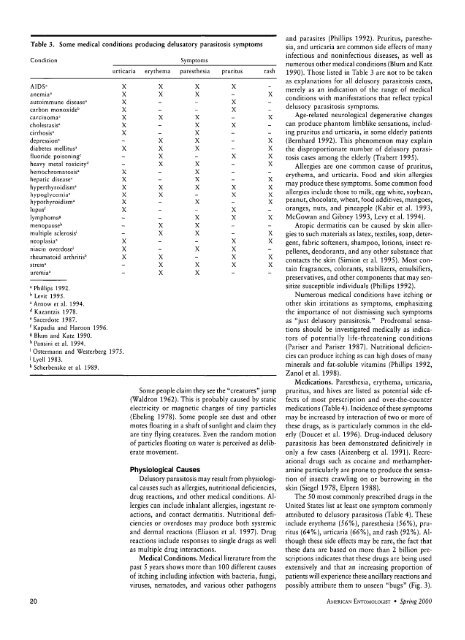Delusory-Parasitosis-Nancy-Hinkle
Delusory-Parasitosis-Nancy-Hinkle
Delusory-Parasitosis-Nancy-Hinkle
Create successful ePaper yourself
Turn your PDF publications into a flip-book with our unique Google optimized e-Paper software.
Table 3. Some medical conditions producing delusatory parasitosis symptoms<br />
Condirion<br />
Some people claim they see the "creatures" jump<br />
(Waldron 1962). This is probably caused by static<br />
electricity or magnetic charges of tiny particles<br />
(Ebeling 1978). Some people see dust and other<br />
motes floating in a shaft of sunlight and claim they<br />
are tiny flying creatures. Even the random motion<br />
of particles floating on water is perceived as deliberate<br />
movement.<br />
Symproms<br />
urticaria erythema paresrhesia<br />
AIDS' X X X<br />
anemia' X X X<br />
auroimmune disease' X<br />
carbon monoxide b<br />
X<br />
carcinoma" X X X<br />
cholestasis' X X<br />
cirrhosis' X X<br />
depression' X X<br />
diabetes mellitus' X X X<br />
fluoride poisoning'<br />
X<br />
heavy metal toxicityd X X<br />
hemochromarosis' X X<br />
hepatic disease' X X<br />
hyperthyroidism' X X X<br />
hypoglycemia' X X<br />
hypothyroidism' X X<br />
lupus f<br />
X<br />
lymphomas<br />
X<br />
menopause h X X<br />
multiple sclerosis' X X<br />
neoplasia'<br />
X<br />
niacin overdosei X X<br />
rheumaroid arthritis k X X<br />
stress' X X<br />
uremia' X X<br />
n Phillips 1992.<br />
b Levit 1995.<br />
C Arnow et a!. 1994.<br />
d Kazantzis 1978.<br />
C Sacerdote 1987.<br />
f Kapadia and Haroon 1996.<br />
g Blum and Katz 1990.<br />
h Pansini et a!. 1994.<br />
i Ostermann and Westerberg 1975.<br />
i Lyell 1983.<br />
k Scherbenske et a!. 1989.<br />
pruritus<br />
Physiological Causes<br />
<strong>Delusory</strong> parasitosis may result from physiological<br />
causes such as allergies, nutritional deficiencies,<br />
drug reactions, and other medical conditions. Allergies<br />
can include inhalant allergies, ingestant reactions,<br />
and contact dermatitis. Nutritional deficiencies<br />
or overdoses may produce both systemic<br />
and dermal reactions (Eliason et al. 1997). Drug<br />
reactions include responses to single drugs as well<br />
as multiple drug interactions.<br />
Medical Conditions. Medical literature from the<br />
past 5 years shows more than 100 different causes<br />
of itching including infection with bacteria, fungi,<br />
viruses, nematodes, and various other pathogens<br />
X<br />
X<br />
X<br />
X<br />
X<br />
X<br />
X<br />
X<br />
X<br />
X<br />
X<br />
X<br />
X<br />
rash<br />
X<br />
X<br />
X<br />
X<br />
X<br />
X<br />
X<br />
X<br />
X<br />
X<br />
X<br />
X<br />
X<br />
X<br />
X<br />
and parasites (Phillips 1992). Pruritus, paresthesia,<br />
and urticaria are common side effects of many<br />
infectious and noninfectious diseases, as well as<br />
numerous other medical conditions (Blum and Katz<br />
1990). Those listed in Table 3 are not to be taken<br />
as explanations for all delusory parasitosis cases,<br />
merely as an indication of the range of medical<br />
conditions with manifestations that reflect typical<br />
delusory parasitosis symptoms.<br />
Age-related neurological degenerative changes<br />
can produce phantom limb like sensations, including<br />
pruritus and urticaria, in some elderly patients<br />
(Bernhard 1992). This phenomenon may explain<br />
the disproportionate number of delusory parasitosis<br />
cases among the elderly (Trabert 1995).<br />
Allergies are one common cause of pruritus,<br />
erythema, and urticaria. Food and skin allergies<br />
may produce these symptoms. Some common food<br />
allergies include those to milk, egg white, soybean,<br />
peanut, chocolate, wheat, food additives, mangoes,<br />
oranges, nuts, and pineapple (Kabir et al. 1993,<br />
McGowan and Gibney 1993, Levy et al. 1994).<br />
Atopic dermatitis can be caused by skin allergies<br />
to such materials as latex, textiles, soap, detergent,<br />
fabric softeners, shampoo, lotions, insect repellents,<br />
deodorants, and any other substance that<br />
contacts the skin (Simion et al. 1995). Most contain<br />
fragrances, colorants, stabilizers, emulsifiers,<br />
preservatives, and other components that may sensitize<br />
susceptible individuals (Phillips 1992).<br />
Numerous medical conditions have itching or<br />
other skin irritations as symptoms, emphasizing<br />
the importance of not dismissing such symptoms<br />
as "just delusory parasitosis." Prodromal sensations<br />
should be investigated medically as indicators<br />
of potentially life-threatening conditions<br />
(pariser and Pariser 1987). Nutritional deficiencies<br />
can produce itching as can high doses of many<br />
minerals and fat-soluble vitamins (Phillips 1992,<br />
Zanol et al. 1998).<br />
Medications. Paresthesia, erythema, urticaria,<br />
pruritus, and hives are listed as potential side effects<br />
of most prescription and over-the-counter<br />
medications (Table 4). Incidence of these symptoms<br />
may be increased by interaction of two or more of<br />
these drugs, as is particularly common in the elderly<br />
(Doucet et al. 1996). Drug-induced delusory<br />
parasitosis has been demonstrated definitively in<br />
only a few cases (Aizenberg et al. 1991). Recreational<br />
drugs such as cocaine and methamphetamine<br />
particularly are prone to produce the sensation<br />
of insects crawling on or burrowing in the<br />
skin (Siegel 1978, Elpern 1988).<br />
The 50 most commonly prescribed drugs in the<br />
United States list at least one symptom commonly<br />
attributed to delusory parasitosis (Table 4). These<br />
include erythema (56%), paresthesia (56%), pruritus<br />
(64%), urticaria (66%), and rash (92%). Although<br />
these side effects may be rare, the fact that<br />
these data are based on more than 2 billion prescriptions<br />
indicates that these drugs are being used<br />
extensively and that an increasing proportion of<br />
patients will experience these ancillary reactions and<br />
possibly attribute them to unseen "bugs" (Fig. 3).<br />
20 AMERICAN ENTOMOLOGIST • Spring 2000


